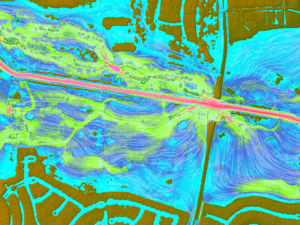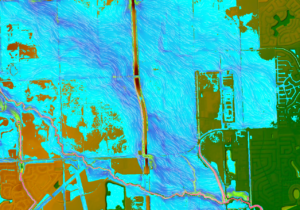Unique Modeling Approaches Lead to the Nation’s Most Comprehensive Flood Hazard Maps
Multiple catastrophic floods, including the 2017 devastation of Hurricane Harvey, underscored the need to better understand — and fortify against — the flood risks facing Houston and surrounding communities in Harris County.
The Harris County Flood Control District (HCFCD) responded by partnering with the Federal Emergency Management Agency (FEMA) on MAAPnext — the Modeling, Assessment and Awareness Project — to produce the nation’s most comprehensive set of flood hazard maps and flood risk data to improve understanding of flood risk and support development of mitigation actions.
As one of only a few consultants selected to complete MAAPnext, Freese and Nichols tapped the expertise of more than 40 professionals across the company, producing next-generation watershed studies through innovative approaches to data management, modeling methodologies, quality control and communication.
Next-Generation Flood Risk Understanding

Several factors prompted the decision to update flood risk information within Harris County, including updated precipitation frequency estimates from NOAA Atlas 14, the availability of high-resolution topographic data, advancements in modeling technology, and a series of significant flood events, most notably Hurricane Harvey.
Hurricane Harvey produced the largest rainfall event ever recorded within the continental U.S., dumping the equivalent of an entire year’s worth of rain in just four days. The resulting flooding led to $125 billion in damages and 65 deaths across the Houston region and Southeast Texas.
In total, there were approximately 155,000 homes in Harris County that flooded during Hurricane Harvey. Of those, a staggering 46% were found to be outside the currently mapped floodplains, indicating the need for improved understanding of flood risk. Advancements in modeling technology, including the ability to represent two-dimensional flow patterns, provided a framework to capture complexities and risks not previously represented by one-dimensional-only models.
The watershed-scale hydrologic and hydraulic models and floodplain mapping that were developed for the 22 watersheds in Harris County will serve as a foundation for the 34 local communities and unincorporated areas to improve the region’s resiliency, preparation and flood risk awareness. MAAPnext is the first project of its kind for FEMA and is expected to serve as a blueprint for similar mapping efforts across the nation.
Innovative Solutions
Innovative approaches were necessary to ensure consistency and quality across the production team and to appropriately model the complex characteristics present in the Cypress Creek, Addicks Reservoir and Sims Bayou watersheds. Insights from the MAAPnext project have the potential to benefit other large-scale modeling projects or projects with large production teams.

Invest in Training
Multiple workshops at the outset of a project and along the way can yield dividends in consistency, efficiency and quality.
- Workshops allowed staff to improve their modeling skills and become familiar with project-specific methodologies. Team members new to Harris County were able to better understand the history and context of the project, client and community.
- As the project progressed, specific staff members performed trial runs of processes to refine them before they were used by the rest of the team.
- Team members shared lessons learned during sessions held at various points of the project, rather than waiting until the end, which led to adjustments that improved outcomes.
Streamline Communication
A comprehensive wiki-style depository using OneNote provides a well-organized, one-stop shop for project information. The centralized information source was continually updated by technical leads and project engineers, helping to clarify guidance, improve consistency, and improve communication and coordination between production staff and reviewers.
- The OneNote notebook could be viewed and edited by multiple users simultaneously; included page links; and was updated quickly when the team received updated guidance, developed a new tool or updated task assignments.
- As an incentive for team members to review all guidance thoroughly, “easter eggs” were embedded, offering the chance to win a Starbucks gift card.
- The depository included key email updates so team members didn’t have to search for them in an overburdened inbox or buried project folder.
Enhance Modeling Consistency
The modeling process was broken down into manageable pieces to standardize model development steps, isolate potential sources of error, and focus attention for the quality control reviews.
- Together with spreadsheets, GIS tools and the OneNote notebook, the standardized modeling processes expedited production and allowed the responsible engineer to focus on complexities requiring judgment rather than getting distracted by tedious or repetitive tasks.
- Consistent organization of every hydraulic model expedited quality control reviews, while standardized progress reporting helped keep the project on schedule.
- Junior staff had an opportunity to build skills: An experienced engineer initially assembled the process outline and steps, then a two-person “fast-track” team worked through the steps to refine the process before it was deployed to the team.
- Separate model components could be developed in parallel and later merged, accelerating the project schedule.
Customize Data Tools
Data management tools were implemented to automate tedious steps, streamline time-consuming tasks, reduce chances for error, and increase the amount of time available for model evaluation and refinement.
- The team devised 20 automation tools, including 13 GIS model-builder scripts, a spreadsheet for slope adjustments, a GIS bathymetry tool and a spreadsheet to automate the transfer of model bridge data. The scripts include 4,000 lines of code. The FIS profile tool provided significant enhancements relative to the standard process using RASPLOT and was adopted by the client for use in all watersheds.
- Freese and Nichols’ technology staff developed a farm of high-speed modeling computers specifically tailored for HEC-RAS simulations that turned around results significantly faster and avoided tying up the computers used to build models.
Use Quality Checks Early
Incorporating quality control reviews at multiple milestones along the course of a project can decentralize execution, encourage junior engineers to take ownership and improve efficiency by catching red flags early.
- Project-specific milestone QC checklists helped ensure consistency with project scope and client guidance, as well as best modeling practices.
- Conducting QC reviews along the way narrowed the scope of what needed to be reviewed each time, which allowed for targeted review of key components, reduced rework and improved model development time. High-quality deliverables were produced by building quality at numerous steps along the way.
- The process included techniques to track QC comments and show whether each one had been addressed to the reviewer’s satisfaction.
- Spatial features and QC comment polygons in a GIS Spatial Database Engine (SDE) enabled multi-user review and editing, including publication to a web-map for project manager and client review.
Freese and Nichols will continue to develop and apply innovative approaches to support improved flood risk understanding and resilience in communities.